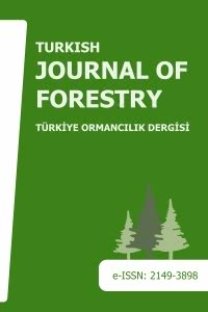Çimentolu yonga levhanın bazı özelliklerine rutubet değişimin etkisinin belirlenmesi
The effects of changing moisture on some mechanical properties of cement- bonded wood particleboard
___
- Biblis, E.J., CF, Lo., 1968. Sugars and other extractives: effect on the setting of southern pine-cement mixtures. For Prod J, 18(8): 28-34.
- Bugrina, M.C., Buchevich, G.A., 1968. Effect of carbohydrates on hydration and hardening of cement. Chem Abstr, 71: 128218k.
- Davis, T.C., 1966. Effect of blue stain on setting of excelsior-cement mixture. For Prod J, 16(6): 49-50.
- EN 310, 1993. Ahşap Esaslı Levhalar, Eğilme ve Eğilme Direnci Elastikiyet Modülünün Tayini, TSE, Ankara.
- English B., 1994. Wastes into Wood. Composites Are a Promising, Forest Products Laboratory, Madison, Wisconsin.
- Forest Products Laboratory, 2001. Wood Handbook. Department of Agriculture, Forest Service, Madison, Wisconsin.
- Goodell, B., Daniei, G., 1997. Decay resistance and microscopic analysis of wood-cement composite. For Prod J, 47(ll-12): 75-80.
- Hochmi, M., Moslemi, A.A., 1989. Correlation between wood- cement compatibility and wood extractives. For Prod J, 39(6): 55-58.
- Hofstrand, A.D., Moslemi, A.A., 1984. Curing characteristics of wood particles from nine northern Rocky Mountain species mixed with Portland cement. For Prod J, 34(2): 57-61.
- Imai, T., Suzuki, M., Aoyama, K., Kawasaki, Y., Yasuda S., 1995. Manufacture of wood cement boards. 6. Cement hardening inhibitory compound of beech (Fagus crenata blume). Mokuzai Gakkaishi, 41: 44-50.
- Infei, M.A., Pulido, O.R., Yamauehi, H., Kawai, S., Sasaki, H., 1998. Manufacture of bamboo-cement composites. V. Effect of sodium silicate on bamboo-cement composite by hot pressing. Mokuzai Gakkaishi, 44: 425- 432.
- Kalaycıoğlu, H., 2005. Karadeniz Teknik Üniversitesi Orman Fakültesi Basılmamış Yonga levha Üretim Teknolojisi Ders Notları.
- Liu, Z.T., Moslemi, A.A., 1986. Influence of chemical
- additives on the hydration characteristics of western larch wood-cement-water mixtures. For Prod J, 35(7-8): 37-43.
- Mallıck, P.K., 1997. Composites Engineering Handbook. Marcel Dekker, Inc., New York.
- Maloney, T.M., 1986. Terminology and products definitions a suggested approch to uniformity worldwide. In Proceedings, 18 th International Union of Forest Research Organization World Congress, Yugoslavia, September, pp. 450.
- Matuana, L.M., Heıden, P.A., 2004. Wood composites. Encyclopedia of Polymer Science and Technology, 12: 521-546.
- Mengeloğlu, F., Alma, M.H., 2002. Buğday saplarının kompozit levha üretiminde kullanılması. Kahramanmaraş Sütçü İmam Üniversitesi Fen ve Mühendislik Dergisi, 5(2): 37-48.
- Moslemi, A.A., 1974. Particleboard (2 vols). Southern Illinois University Press, Carbondale, IL, pp. 185-186.
- Moslemi, A.A., Lim, Y.T., 1984. Compatibility of southern hardwoods with portland cement. For Prod J, 34(7-8): 22-26.
- Moslemi, A.A., 1988. Inorganically bonded wood composites. Chemtech, 18:504-510.
- Nagadomi, W., Kuroki, Y., Eusebio, D.A., Linfei, M.A., Kawai, S., Sasaki, H., 1996. Rapid curing of cement- bonded particleboard. V. Mechanism of strength development with fortifiers and accelerators durins steam injection pressing. Mokuzai Gakkaishi, 42: 977- 991.
- Nagadomi, W., Kuroki, Y., Kawai, S., Sasaki, H., 1996. Rapid curing of cement-bonded particleboard with silica fume. II. Effect of autoclave curing on cement hydration. Mokuzai Gakkaishi, 42: 1202-1210.
- Prestemon, D.R., 1975. Preliminary evaluation of a wood- cement composite. For Prod J, 26: 43-58.
- Ramirez-Coretti, A., Eckelman, C.A., 1998. Inorganic- bonded composite wood panel systems for low-cost housing: a Central American perspective. For Prod J, 48(8): 62-68.
- Sandermann, W., Preusser, H.J., Schwiens W., 1960. The effect of wood extractives on the setting of cement- bonded wood materials. Holzforschung, 14(3): 70-77.
- Sandermann, W., Kholer, R., 1964. Studies on mineral- bonded wood materials. Holzforschung, 18(12): 53-59.
- Sauvat, N., Sell, N., 1999. A study of ordinary portland cement hydration with wood by isothermal calorimeter. Holzforschung, 53: 104-108.
- Simatupang, M.H., Seddig, N., Habighorst, C., Geimer, R.L., 1991. Technology for rapid production of mineral- bonded wood composites boards. For Prod Res Soc, 2: 18-27.
- Sudin, R., Ibrahim, W.A., 1990. Cement bonded particleboard from Acacia mangium, a preliminary study. J Trop For Sci, 2: 267-273.
- TS EN 633, 1999. Çimentolu Yonga Levhalar - Tarif ve Sınıflandırma, TSE, Ankara.
- TS EN 13446, 2005. Ahşap esaslı levhalar – Bağlayıcıların geri çıkma kapasitesinin tayini, TSE, Ankara.
- Weatherwax, R.C., Tarkow, H., 1964. Effect of wood on setting of Portland cement. Forest Product J, 14: 567- 570.
- ISSN: 1302-7085
- Yayın Aralığı: Yılda 2 Sayı
- Başlangıç: 2000
Ormaniçi merada ağaç sıklığının bitki örtüsü üzerine etkileri
Bitki kökleriyle şev stabilizasyonun sonlu elemanlar yöntemiyle incelenmesi
Ali Kemal ARKUN, MUSTAFA ERGEN, FERİT ÇAKIR
Çimentolu yonga levhanın bazı özelliklerine rutubet değişimin etkisinin belirlenmesi
FATİH YAPICI, HÜSEYİN YÖRÜR, İLKER YALÇIN
Antalya yöresi doğal kızılçam meşcereleri için genelleştirilmiş çap-boy modellerinin geliştirilmesi
Ormanların heyelan oluşumu üzerindeki etkileri
MUSTAFA YILMAZ, FATİH TONGUÇ, Tolga OK
Isıl işlem uygulanmış bazı ağaç malzemelerde yapışma direncinin belirlenmesi
Sürdürülebilir orman yönetimi ölçüt ve göstergelerinin Türkiye için modellenmesi
YASİN KARATEPE, Ramazan ÖZÇELİK, NEVZAT GÜRLEVİK, HAKKI YAVUZ, Rüstem KIRIŞ
